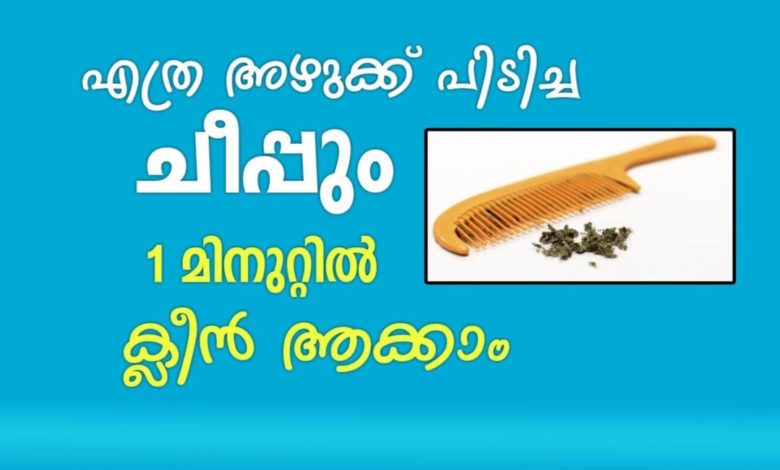How to Clean Combs and Brushes

If this happens to be a chore you dread, it can be most of the time why your combs and brushes are filled with buildup and gunky residue. They don’t must be. By cleansing out your brushes, no longer handiest are you getting your tools clean and sanitary, you’re doing all your hair and scalp a gigantic desire the following time you comb and brush your hair.
for watch detailed video about How to Clean Combs and Brushes, see below. for getting daily updates follow our facebook page and click see first option in following button. if you interested this. give this post to your friends and relatives.for more videos, subscribe now:Grandmother Tips
There isn’t any use in taking the time to shampoo and situation your hair quite often should you put dirty tools again on it, is there? Styling your hair with dirty combs and brushes is not exactly a healthful hair apply. This easy step-by way of-step walks you via the process of cleaning your daily styling tools and if you do it, you can see that it does not take long at all—a majority of the time is spent soaking and drying, two procedures that do not require your involvement or awareness!
01.What you’ll want
Combs and/or brushes that need cleaning
Shampoo
An historical toothbrush
Baking soda (non-compulsory)
02.Pull unfastened Hairs Out of Your Brush
through pulling any free hairs out of your brush by means of hand. Ideally, that is whatever you do after at any time when you brush your hair. If you happen to do not do it on a day-to-day foundation, this may occasionally make the effort, however don’t fear about getting every hair out of the bristles. Simply try to dislodge as many loose ones as that you could earlier than relocating on. The less hairs you’ve got stuck to the comb, the less complicated it’ll be to wash it once you put it into the water.
03.Use a Comb to drag Out Hairs
Now you can use your comb to remove further hairs, those that weren’t loose ample to with ease do away with together with your fingers. With no trouble begin on the base of the comb and transfer the comb upwards, pulling away hairs as you go. Throw all of the hair away as you go via the system. If you’re cleansing quite a lot of combs, use one with the best teeth for this step; the carefully-spaced teeth will eliminate extra hair than a wide-teeth one.
04.Dunk Combs and Brushes in Water
Fill a smooth sink with sizzling, soapy water. A clarifying shampoo works well for cleaning considering that they may be designed to put off oily buildup and residue from the hair. If you shouldn’t have a clarifier, a basic shampoo is pleasant to use. Wholly submerge your hair tools within the water and let them soak for roughly 1/2 an hour. Including a tablespoon of baking soda isn’t a bad idea for additional oil cutting, so feel free to toss in a little bit of this low-cost loved ones staple if you want.
Restrict boiling your tools or making use of bleach. The high temperatures of boiling water can damage down your instruments, slicing their size of use by a massive quantity. Plus, bleach can also be problematic to fully wash out of bristles, leaving you at threat of getting bleach for your hair the next time you sweep it. No thanks.
05.Use an historical Toothbrush to wash Comb
if your comb has greasy residue sticking to the base of the enamel, use an historical toothbrush to remove it. Add a dab of shampoo to the toothbrush and scrub the buildup away. This is a good strategy to reuse an unwanted item, but you can also need to store this old toothbrush in a separate situation from the one you utilize for your teeth daily—you do not need to mistakenly grab this one the subsequent time you brush your teeth!
06.Scrub Brush with your Fingers
After soaking your brush for a even as, use your fingers for additional scrubbing. Add more shampoo if wanted to work up a gentle lather. Just transfer your fingers via your brush the same manner you might use a nail brush to wash your fingernails. If your brush bristles are product of nylon, do that step slowly and gently—nylon bristles are typically tougher than usual boar bristles, and you do not need to cut your self for the duration of this step. This is one rationale boar bristle brushes are recommended for black hair; nylon tends to be too rough on our soft strands.
07.Allow Time to Air Dry
situation your combs and brushes on a towel, washcloth or paper towel and let them air dry. Combs dry slightly rapidly, but it will take a day or more to your brush to utterly dry. Retailer it with the bristles down with a view to let as a lot of the water drain as possible. This is why it’s a excellent inspiration to have more than one brush on your collection—whilst one dries, you still have one more to be had if needed. As soon as dry, your easy tools are actually able to use!


